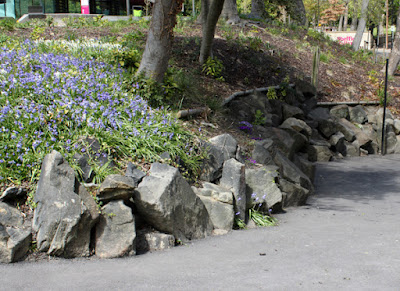 |
| The east wing of Broom Hall |
At the end of my brief exploration of the Broomhall Estate around the Collegiate Campus, I walked down from the Oaklands building to Collegiate Crescent and was interested to see an area of rockery, which forms a landscaped border to the drive.
Looking more closely at these, I could see that they comprise large pieces of coarse gritty sandstone, which look like natural loose blocks that have been brought here from one of the gritstone edges found along the Rivelin and Loxley Valleys to the north-west of Sheffield.
Amongst these is a sizeable block of Carboniferous Limestone from the Peak District in Derbyshire, which displays densely packed Gigantoproductus brachiopod fossils similar to those found in the Lathkill Shell Bed of the Monsal Dale Limestone Formation.
Another limestone block contains vein calcite, which is in a both a bladed crystal habit and more massive in nature, where the rhombohedral cleavage is visible and, although I didn’t inspect it closely, one has a very open sponge like texture that could be tufa.
Continuing along Broomhall Road, there are several Victorian houses - some which predate the wholesale development of the estate - which are built in various sandstones. I could only view these from the pavement, but the earlier houses are built in sandstone ashlar that looks quite similar to the Sheffield Hallam University Main Building, with the later Gothic Revival houses being built in stone with greater colour variation, with iron staining.
At No. 4 Park Lane, which I could just see over the boundary wall and hedge, the walling stone is in irregularly sized and relatively thin courses and, in places, has distinct iron staining. Looking at the boundary wall, which is thinly bedded and iron stained, I think that this is likely to be Greenmoor Rock, obtained from the quarries less than 2 km away at Brincliffe Edge.
The adjacent Grade II* Listed Broom Hall dates back to c.1500, but I could only get photos of the early C17 south elevation and the late C18 east wing with my telephoto lens. Blowing up my photos, it looks like the south elevation is built in a thinly coursed sandstone similar to No. 4 Park Lane, but the later extension is built in ashlar with grey/orange colour variation that is consistent with the Loxley Edge Rock.
Continuing along Broomhall Road, there are further houses that were built before 1855, as shown on the Ordnance Survey map, which I could only view from a distance but look like they have had different sandstones used in their construction.
On the corner with Wharncliffe Street, there is the lodge built for the Broomhall Estate c.1830, beyond which the architecture changes to brick built terraced houses that date to the first half of the C19, but which are of a much better quality than the later worker’s houses.









No comments:
Post a Comment